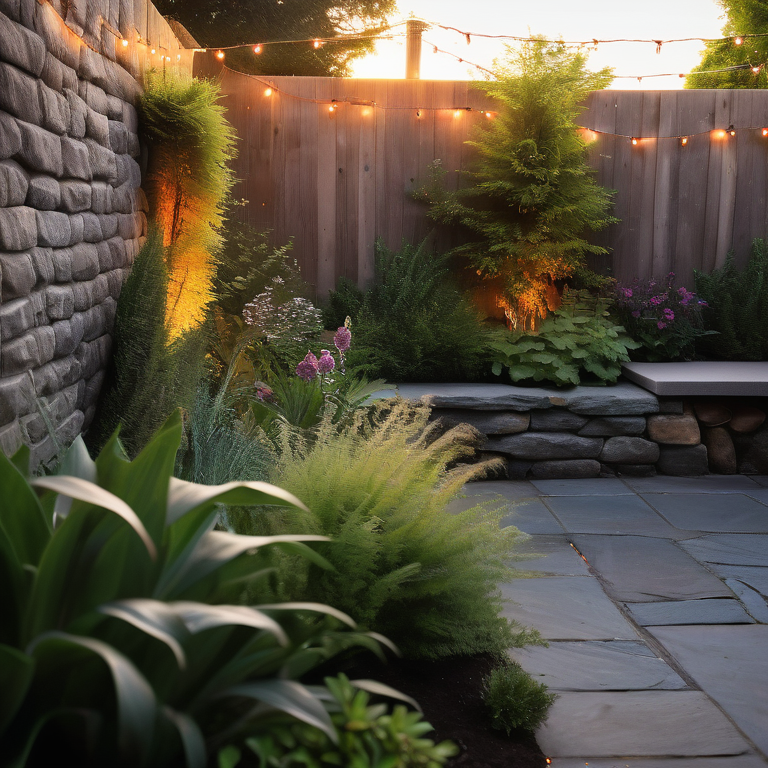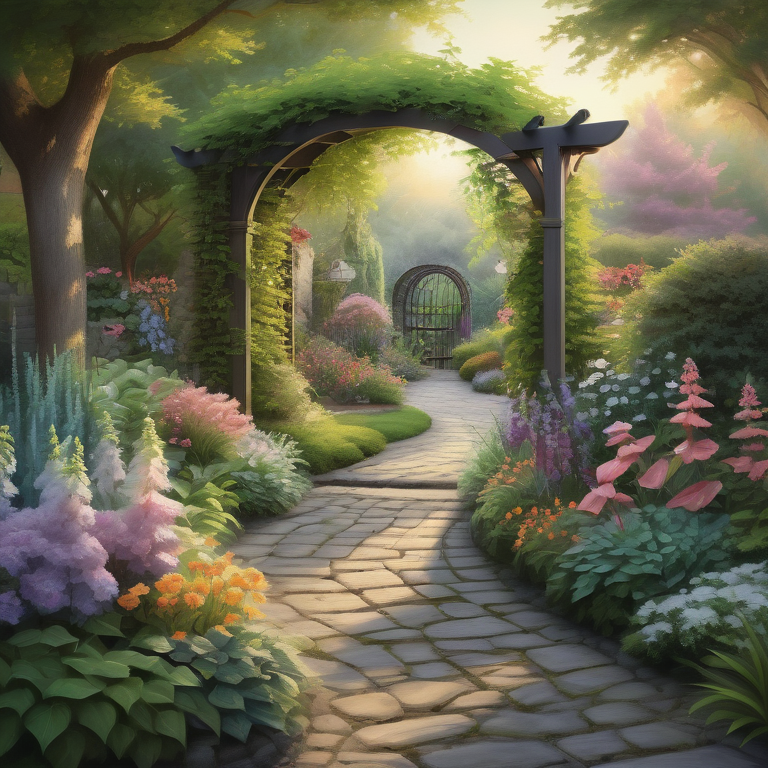What are some key elements to consider when designing a small garden?
When designing a small garden, consider maximizing vertical space with trellises or hanging plants, using multipurpose furniture for seating and storage, incorporating mirrors to create depth, opting for small-scale plants, and ensuring good lighting for both aesthetics and plant growth.
What are some key elements to consider when designing a small garden?
When designing a small garden, consider utilizing vertical space with hanging planters or trellises, choosing plants that suit the garden’s size, maximizing natural light, incorporating multi-functional furniture, and creating focal points to draw the eye and add visual interest to the limited space.
Key Highlights
- Transform your small garden into a stylish outdoor space with these 25 design ideas.
- Maximize space with vertical gardening, incorporating water features for serenity, and using mirrors to enhance the sense of space.
- Choose multi-functional outdoor furniture, implement a color scheme to unify the space, and create cozy nooks with strategic planting.
- Employ hanging baskets for layers of green, build raised beds to maximize planting area, and integrate edible plants in decorative ways.
- Install lighting to highlight features, craft a miniature Zen garden for peace, and utilize pathways to define areas.
- Select dwarf varieties of trees and shrubs, experiment with DIY container gardens, and embrace a minimalist approach for clarity.
- Design with perennials for longevity, attract wildlife with native plantings, and incorporate sustainable gardening practices.
- Create a focal point with a statement piece and add texture with varied plant types.
- Optimize space with espaliered fruit trees, design for privacy with fast-growing hedges, and make use of underutilized spaces.
Introduction
Creating a stylish and functional outdoor space is possible even with a small garden. With the right design ideas and strategies, you can transform your compact outdoor area into a beautiful and inviting oasis. Whether you have a tiny garden, a small patio, or a balcony, there are numerous ways to maximize the space and create a stylish outdoor area that reflects your personal taste and style and makes a big impact.
In this blog, we will explore 25 small garden design ideas to make your patch of outdoor space a blessing, however tiny it may be. From utilizing vertical gardening techniques to incorporating water features for serenity, there are plenty of small garden ideas that will inspire you to create a stylish and functional outdoor area that you can enjoy year-round. It’s been proven time and again what a huge benefit having a garden makes to our mental health, so let’s get started!
25 Creative Small Garden Design Ideas
If you have a small garden or outdoor space, it’s important to make every inch count. Here are 25 creative small garden design ideas to help you make the most of your limited space.
1. Maximizing Space with Vertical Gardening
Vertical gardening is a great way to maximize the use of vertical space in a small garden. By utilizing walls and vertical structures, you can create a stunning living wall or add wall planters to grow a variety of plants. This technique not only frees up room, but it also creates an instant impact in your garden. Here are some tips to maximize space with vertical gardening:
- Install a living wall: A living wall is a vertical garden that can be installed on a wall or fence. It consists of pockets or trays that hold plants, allowing you to create a lush and vibrant vertical garden.
- Use wall planters: Wall planters are another great option for vertical gardening. You can hang them on a wall or fence and fill them with a variety of plants, herbs, or even flowers.
- Grow climbing plants: Climbing plants, such as ivy or jasmine, can be trained to grow vertically along a wall or trellis, adding height and greenery to your small garden.
- Utilize hanging baskets: Hanging baskets are an excellent way to add layers of greenery to your small garden. Hang them from walls, pergolas, or even trees to create a multi-dimensional and visually appealing space.
- Consider a vertical vegetable garden: If you’re short on floor space, consider growing vegetables vertically. Install trellises or vertical planters to grow vegetables like tomatoes, cucumbers, or beans. www.wicklowlandscaping.ie
2. Incorporating Water Features for Serenity
Adding a water feature to your small garden can create a sense of serenity and tranquility. The sound of flowing water can help mask noise from nearby streets or neighbors and create a soothing ambiance. Here are some ideas for incorporating water features in your small garden:
- Install a small fountain: A small fountain can be a focal point in your garden and add a calming element to the space. Opt for a compact, self-contained fountain that doesn’t require a lot of space or maintenance.
- Create a small pond or water garden: If you have a bit more space, consider creating a small pond or water garden. You can add aquatic plants, such as water lilies or lotus, to enhance the beauty of the water feature.
- Incorporate a water wall: A water wall is a vertical water feature that can be installed on a wall or fence. It creates a stunning visual effect and adds a touch of elegance to your garden.
- Combine a water feature with seating: Create a seating area near your water feature to fully enjoy the serene atmosphere. Add comfortable outdoor cushions and create a cozy nook where you can relax and unwind. www.wicklowlandscaping.ie
3. Using Mirrors to Enhance the Sense of Space
Mirrors are not just for interior design—they can also be used to enhance the sense of space in a small garden. By strategically placing mirrors in your outdoor area, you can create the illusion of a larger space and make your front garden feel more expansive. Here are some ideas for using mirrors in your small garden:
- Hang a mirror on a wall: Hang a mirror on a wall or fence to create the illusion of depth and make your garden feel bigger. Choose a mirror with a decorative frame that complements your outdoor decor.
- Install a mirror on a shed or structure: If you have a shed or structure in your garden, consider installing a mirror on one of the walls. This will reflect the surrounding greenery and make the space feel more open.
- Place a mirror on the ground: Place a mirror on the ground in a strategic location to create the illusion of a hidden garden or pathway. This can add a touch of whimsy and make your garden feel larger than it is.
- Use mirrored planters or accessories: Choose planters or accessories with mirrored surfaces to add a reflective element to your garden. This will create a sense of depth and make your small garden feel more spacious. www.wicklowlandscaping.ie
4. Choosing Multi-functional Outdoor Furniture
When space is limited, choosing multi-functional outdoor furniture is essential. Not only does it save space, but it also allows you to make the most of your small garden. Here are some ideas for choosing multi-functional outdoor furniture:
- Opt for folding furniture: Folding furniture is a great option for small gardens or balcony gardens. You can easily fold and store the furniture when not in use, providing more floor space for other activities.
- Choose furniture with built-in storage: Look for outdoor furniture that doubles as storage. For example, benches with built-in storage compartments or coffee tables with hidden storage can provide a place to sit and store garden tools, cushions, or other outdoor essentials.
- Consider modular furniture: Modular furniture allows you to rearrange and customize your outdoor seating area according to your needs. You can easily move the pieces around to create different seating arrangements or extend the furniture to accommodate more guests.
- Invest in compact furniture: Look for compact furniture designs that are specifically made for small spaces. There are plenty of options available, including bistro sets, compact dining tables, and chairs that can be stacked or folded when not in use.
5. Implementing a Color Scheme to Unify the Space
Implementing a color scheme in your small garden can help unify the space and create a cohesive and visually appealing design. Here are some tips for using color schemes in your small garden:
- Choose a color palette: Start by choosing a color palette that reflects your personal style and complements your outdoor space. Consider the colors of your existing furniture, plants, and accessories and select colors that harmonize with them.
- Create a focal point: Use color to create a focal point in your small garden. This could be a brightly colored feature wall, a vibrant flower bed, or a statement piece of furniture. The focal point will draw the eye and add visual interest to the space.
- Use colors strategically: Use lighter colors to make your small garden feel more open and spacious. Light-colored walls, furniture, and planters can create the illusion of more space. Darker colors can add depth and create a more intimate and cozy atmosphere.
- Consider the color of plants: When choosing plants for your small garden, consider their colors and how they will contribute to your overall color scheme. Use plants with complementary colors to create a harmonious and visually appealing design. www.wicklowlandscaping.ie
6. Creating Cozy Nooks with Strategic Planting
In a small garden, creating cozy nooks can make the space feel more inviting and intimate. By strategically placing plants and furniture, you can carve out small seating areas where you can relax and unwind. Here are some ideas for creating cozy nooks in your small garden:
- Use plants to create privacy: Plant tall, leafy plants or install trellises with climbing plants to create a sense of privacy and seclusion in your small garden. This will make your seating area feel more intimate and cozy.
- Create a seating area with potted plants: Place a cluster of potted plants around a seating area to create a sense of enclosure and make the space feel more cozy. Use plants with different heights and textures to add visual interest.
- Install a pergola or canopy: Install a pergola or canopy over your seating area to provide shade and create a cozy outdoor room. Add curtains or drapes to create a sense of privacy and create an intimate atmosphere.
- Use comfortable outdoor furniture: Choose comfortable outdoor furniture, such as lounge chairs or cozy benches, for your seating area. Add cushions and throws to make the space feel inviting and cozy. www.wicklowlandscaping.ie
7. Employing Hanging Baskets for Layers of Green
Hanging baskets are a great way to add layers of greenery to your small garden. They not only save space but also create a visually appealing and vibrant outdoor space. Here are some ideas for employing hanging baskets in your small garden:
- Hang baskets from walls or fences: Hang baskets from walls or fences to add vertical interest to your small garden. You can hang them at different heights to create a cascading effect and add depth to the space.
- Choose a variety of plants: Fill your hanging baskets with a variety of plants, including trailing plants, flowering plants, and foliage plants. This will create a lush and vibrant display.
- Hang baskets from pergolas or arbors: If you have a pergola or arbor in your small garden, hang baskets from them to create a beautiful and fragrant overhead display. This will add a sense of enchantment and make your outdoor space feel more magical.
- Create a hanging garden: Hang multiple baskets at different levels to create a hanging garden. This will make your small garden feel more dynamic and visually interesting.
8. Building Raised Beds to Maximize Planting Area
Building raised beds is a great way to maximize the planting area in your small garden. By creating elevated spaces for planting, you can grow a variety of plants and vegetables in a compact and organized manner. Here are some tips for building raised beds in your small garden:
- Determine the location: Choose a sunny spot in your garden for your raised beds. Most vegetables and plants require at least 6 hours of direct sunlight per day.
- Select the materials: Choose the materials for your raised beds, such as wood or stone. Consider the aesthetics, durability, and cost of the materials.
- Determine the size: Determine the size of your raised beds based on the available space in your garden and the types of plants you want to grow. Keep in mind that raised beds should be narrow enough for easy access from all sides.
- Prepare the soil: Before filling the raised beds with soil, prepare the ground by removing any grass or weeds. Fill the beds with a mixture of compost, topsoil, and organic matter to create a nutrient-rich environment for your plants.
- Plant a variety of vegetables and herbs: Once your raised beds are ready, plant a variety of vegetables and herbs, such as salad leaves, tomatoes, cucumbers, and herbs. www.wicklowlandscaping.ie
9. Integrating Edible Plants in Decorative Ways
Integrating edible plants into your small garden is not only practical but also adds beauty and interest to your outdoor space. Here are some ideas for integrating edible plants in decorative ways:
- Create a small vegetable garden: Dedicate a small area in your garden for growing vegetables. You can use raised beds, pots, or planters to grow a variety of vegetables, such as tomatoes, peppers, lettuce, and herbs.
- Mix edible plants with ornamental plants: Integrate edible plants, such as strawberries or herbs, with ornamental plants to create a visually appealing and productive garden. This will add interest and variety to your small garden.
- Use edible plants as accents: Use edible plants as accents throughout your garden. For example, plant sweet peas along a fence or trellis to add a pop of color and fragrance to your outdoor space.
- Incorporate edible flowers: Many edible flowers, such as nasturtiums and pansies, are not only beautiful but also add flavor and interest to your dishes. Plant them in pots or flower beds to add color and texture to your small garden.
10. Installing Lighting to Highlight Features
Installing lighting in your small garden can create a magical and inviting atmosphere, especially in the evening hours. Here are some ideas for installing lighting to highlight features in your outdoor space:
- Use solar lights: Solar lights are an eco-friendly and cost-effective way to illuminate your small garden. Place them along pathways, around seating areas, or near features you want to highlight.
- Install string lights: String lights can add a warm and cozy ambiance to your garden. Hang them along fences, pergolas, or trees to create a festive and inviting atmosphere.
- Highlight focal points: Use spotlights or uplights to highlight focal points in your garden, such as a statue, a tree, or a water feature. This will draw attention to these features and create a dramatic effect.
- Use lanterns or candles: Lanterns or candles can add a romantic and intimate ambiance to your small garden. Place them on tables, hang them from trees, or line them along pathways to create a soft and inviting glow. www.wicklowlandscaping.ie
11. Crafting a Miniature Zen Garden for Peace
If you’re looking to create a peaceful and tranquil space in your small garden, consider crafting a miniature Zen garden. Here are some ideas for creating a Zen garden in a tiny space:
- Choose a focal point: Select a small area in your garden as the focal point of your Zen garden. This could be a small patch of gravel, a mini meditation area, or a small courtyard surrounded by plants.
- Use gravel and rocks: Use gravel or small rocks to create patterns and ripples in your Zen garden. Rake the gravel to create soothing patterns that mimic the flow of water.
- Add plants and moss: Incorporate plants and moss into your Zen garden to create a lush and serene atmosphere. Choose plants with simple and elegant forms, such as bamboo or Japanese maple, to complement the Zen aesthetic.
- Include a water feature: Consider adding a small water feature, such as a mini waterfall or a small pond, to your Zen garden. The sound of flowing water will further enhance the sense of serenity and peace.
- Keep it simple: Keep the design of your Zen garden simple and minimalist. Avoid clutter or excessive decorations. The focus should be on creating a tranquil and harmonious space.
12. Utilizing Pathways to Define Areas
In a small garden, pathways can be used to define different areas and create a sense of structure and organization. Here are some ideas for utilizing pathways in your small garden:
- Create a focal point: Use a pathway to lead the eye to a focal point in your garden, such as a sculpture, a water feature, or a seating area. This will create a sense of anticipation and make your garden more interesting to explore.
- Divide the garden into sections: Use pathways to divide your garden into different sections or areas. For example, you can have a pathway that leads to a seating area, another pathway that leads to a vegetable patch, and a third pathway that leads to a flower bed. This will create a sense of order and structure in your small garden.
- Use different materials: Use different materials for your pathways to add visual interest and create distinct areas. For example, use gravel for one pathway, stepping stones for another, and wood chips for a third.
- Use curves and bends: Instead of straight pathways, consider using curves and bends to create a more organic and flowing design. Curved pathways can make your small garden feel more spacious and inviting. www.wicklowlandscaping.ie
13. Selecting Dwarf Varieties of Trees and Shrubs
In a small garden, selecting dwarf varieties of trees and shrubs is a smart choice. These compact plants not only fit well in small spaces but also require less maintenance and pruning. Here are some examples of dwarf varieties that are suitable for small gardens:
- Dwarf Japanese maple: These small trees are known for their stunning foliage and compact size. They come in a variety of colors and can add a touch of elegance to your small garden.
- Dwarf conifers: Dwarf conifers, such as compact spruces or junipers, are perfect for adding texture and structure to a small garden. They require minimal pruning and stay small in size.
- Dwarf hydrangeas: Dwarf hydrangeas are smaller versions of the popular flowering shrubs. They still produce beautiful blooms but on a smaller scale, making them ideal for small gardens or containers.
- Dwarf roses: If you love roses but have limited space, consider planting dwarf rose varieties. They still produce stunning but have a compact growth habit, making them suitable for small gardens or containers. www.wicklowlandscaping.ie
14. Experimenting with DIY Container Gardens
Container gardening is a great way to add greenery and color to your small garden. With DIY container gardens, you can get creative and personalize your outdoor space. Here are some ideas for experimenting with DIY container gardens:
- Upcycle old containers: Use old buckets, cans, or even mason jars as plant pots. Paint them in vibrant colors or create a rustic look by leaving them as they are.
- Create a vertical garden with hanging containers: Hang plant pots from a trellis, a pergola, or even from tree branches to create a stunning vertical garden. You can mix and match different plants and colors to create a vibrant display.
- Use unconventional containers: Get creative with your choice of containers. Use old teapots, boots, or even an old bicycle basket as planters. This will add a touch of whimsy and personality to your small garden.
- Mix and match different plants: Experiment with different plants and create unique combinations in your container gardens. Mix flowers, herbs, and even vegetables to create a colorful and functional display.
15. Adopting a Minimalist Approach for Clarity
A minimalist approach to garden design can create a sense of clarity and simplicity in a tiny garden. Here are some ideas for adopting a minimalist approach in your small garden:
- Use a limited color palette: Stick to a limited color palette to create a cohesive and harmonious design. Choose one or two main colors and use different shades and textures to add variety.
- Focus on clean lines and geometric shapes: Emphasize clean lines and geometric shapes in your garden design Use straight pathways, rectangular planters, and simple furniture to create a minimalist and modern look.
- Remove clutter: Keep your small garden clean and clutter-free. Remove any unnecessary decorations or plants that may overcrowd the space. Focus on a few key elements and let them shine.
- Embrace negative space: Leave empty space in your garden to create a sense of calm and balance. Negative space can enhance the beauty of your plants and make your small garden feel more spacious. www.wicklowlandscaping.ie
16. Embracing the Charm of a Wildflower Meadow
If you’re looking to add a touch of whimsy and natural beauty to your small garden, consider embracing the charm of a wildflower meadow. Here are some ideas for creating a wildflower meadow in your garden space:
- Choose native wildflowers: Select native wildflowers that are well-suited to your climate and growing conditions. These plants are adapted to the local environment and will require less maintenance.
- Prepare the soil: Prepare the soil by removing any grass or weeds and loosening it with a garden fork or tiller. This will create a favorable environment for the wildflowers to grow.
- Sow the seeds: Scatter the wildflower seeds evenly over the prepared soil. Lightly press them into the soil and water gently.
- Maintain the meadow: Allow the wildflowers to grow and bloom naturally. Avoid mowing or trimming the meadow too frequently to encourage the growth of wildflowers.
- Enjoy the beauty: Sit back and enjoy the beauty of your wildflower meadow as it attracts pollinators and adds a burst of color to your small garden. www.wicklowlandscaping.ie
17. Planning for Seasonal Color and Interest
Planning for seasonal color and interest is essential in a small garden. By selecting plants that bloom at different times of the year, you can ensure that your garden always has something in bloom. Here are some tips for planning for seasonal color and interest in your small garden:
- Choose a variety of flowering plants: Select flowering plants that bloom in different seasons, such as spring bulbs, summer perennials, and fall foliage plants. This will ensure that your garden has color and interest year-round.
- Create flower beds: Design flower beds or plant borders that feature plants with different bloom times. Arrange the plants strategically to create a visually appealing and dynamic display.
- Consider foliage plants: Foliage plants, such as ornamental grasses or plants with colorful leaves, can also add interest and texture to your small garden. Choose plants with different leaf shapes and colors to create a visually appealing design.
18. Designing With Perennials for Longevity
Designing with perennials is a great way to ensure longevity and sustainability in your small garden. Here are some ideas for designing with perennials:
- Choose long-lived perennials: Select perennials that have a long lifespan and require minimal maintenance. Examples include daylilies, hostas, and peonies.
- Plan for different bloom times: Choose perennials that bloom at different times of the year to ensure that your garden has color and interest throughout the seasons. Combine early spring bloomers with late summer or fall bloomers for a continuous display.
- Consider the growth habit: When selecting perennials, consider their growth habit and size. Choose compact varieties or ones that can be easily divided to prevent overcrowding in your small garden.
- Create a perennial border: Design a perennial border along the edges of your garden or pathways. Arrange the perennials to create a beautiful and cohesive display that will last for years to come. www.wicklowlandscaping.ie
19. Attracting Wildlife with Native Plantings
Attracting wildlife to your small garden can add a sense of vibrancy and biodiversity to the space. Here are some ideas for attracting wildlife with native plantings:
- Choose native plants: Select native plants that are well-suited to your local environment and attract native wildlife. Native plants provide food and shelter for birds, butterflies, and other beneficial insects.
- Create a wildlife-friendly habitat: Design your garden to provide a variety of habitats, such as nesting sites, food sources, and water sources. Incorporate bird feeders, birdbaths, and native plants that produce fruits or nectar.
- Avoid the use of pesticides: Minimize the use of pesticides in your garden to create a healthy and safe environment for wildlife. Instead, choose organic pest control methods and encourage natural predators to keep pest populations in check.
- Provide water sources: Install a small pond, birdbath, or water feature to provide water for wildlife. Make sure to clean and refill the water sources regularly.
20. Incorporating Sustainable Gardening Practices
Incorporating sustainable gardening practices in your small garden not only benefits the environment but also creates a healthier and more productive space. Here are some ideas for incorporating sustainable gardening practices:
- Compost kitchen and garden waste: Start a compost heap or use a compost bin to recycle kitchen and garden waste. This will reduce the amount of waste sent to landfills and provide nutrient-rich compost for your plants.
- Use organic fertilizers and pest control methods: Opt for organic fertilizers and pest control methods to minimize the use of synthetic chemicals. Organic fertilizers and pest control products are safer for the environment and promote healthier plant growth.
- Conserve water: Install a rain barrel to collect rainwater for watering your plants. Use a watering can or drip irrigation system to minimize water waste and ensure that water reaches the roots of your plants.
- Use sustainable materials: Choose sustainable materials for your garden, such as reclaimed wood for raised beds or natural stone for pathways. Avoid using plastic or synthetic materials whenever possible.
- Use hand tools: Opt for hand tools instead of power tools to reduce energy consumption and noise pollution. Hand tools are also more precise and allow for more delicate tasks in a small garden.
21. Creating a Focal Point with a Statement Piece
Creating a focal point in your small garden with a statement piece can add visual interest and serve as a centerpiece for your outdoor space. Here are some ideas for creating a focal point with a statement piece:
- Choose a unique sculpture or art installation: Select a visually striking sculpture or art installation to serve as the focal point of your garden. Choose a piece that complements your outdoor decor and reflects your personal style.
- Install a striking water feature: A water feature, such as a fountain or a small pond, can create a focal point and add a sense of tranquility to your small garden. Choose a water feature that suits the size and style of your outdoor space.
- Incorporate a bold piece of furniture: Use a bold piece of furniture, such as a brightly colored bench or a unique seating arrangement, to create a focal point in your garden. Place the furniture in a strategic location where it can be easily seen and admired. www.wicklowlandscaping.ie
22. Adding Texture with Varied Plant Types
Adding texture to a small garden is essential to create visual interest and make the space feel more dynamic. One way to achieve this is by incorporating varied plant types. Consider mixing plants with different leaf shapes, sizes, and colors to create contrast and texture. For example, you can combine plants with broad, lush leaves with those that have feathery or spiky foliage. Additionally, choose plants with different bloom times to ensure that there is always something flowering in your garden. This creates a sense of movement and keeps the space visually appealing throughout the seasons. By carefully selecting and arranging plants, you can create a small garden that feels rich in texture and full of life. www.wicklowlandscaping.ie
23. Optimizing Space with Espaliered Fruit Trees
Espaliered fruit trees are a perfect solution for optimizing space in a small garden. These trees are trained to grow flat against a wall or trellis, which allows them to take up minimal space while still producing a bountiful harvest of fruits. By training the branches to grow horizontally, you can create a beautiful, artistic display that adds interest and charm to your outdoor space. Espaliered fruit trees are also a great option for small gardens with limited sunlight, as they can be positioned in a sunny spot against a wall or fence to maximize exposure to sunlight. Not only do these trees provide fresh fruits, but they also serve as a stunning focal point in your garden. www.wicklowlandscaping.ie
24. Designing for Privacy with Fast-Growing Hedges
Privacy is often a concern in small gardens, especially if you live in a densely populated area. Designing with fast-growing hedges can provide an effective solution. Choose hedge varieties that are known for their rapid growth and dense foliage, such as Leyland cypress, arborvitae, or privet. These hedges can quickly fill in empty spaces and create a natural barrier, giving you the privacy you desire. Additionally, hedges can also act as a backdrop for other plants and serve as a green wall to add depth and visual interest to your garden. By strategically placing fast-growing hedges in your small garden, you can create a secluded oasis where you can relax and enjoy your outdoor space in peace.
25. Making Use of Underutilized Spaces
Small gardens often have underutilized spaces that can be transformed into functional and beautiful areas. Look for areas such as the side yard or balcony that are often neglected and turn them into a green oasis. Consider installing vertical gardens or hanging planters to maximize space and add greenery to walls or fences. Use containers and raised beds to create a vegetable patch or herb garden. By utilizing these underutilized spaces, such as with the addition of Verbena bonariensis, you can make the most of your small garden and create a stylish outdoor area that is both functional and visually appealing. Don’t let any space go to waste – get creative and make your small garden feel larger than life. www.wicklowlandscaping.ie
Key Takeaways on Small Garden Design
- Transform your small garden into a stylish outdoor space by following key design principles
- Choose the right color schemes and incorporate design tricks like repetition and focal points
- Optimize space by using espaliered fruit trees and fast-growing hedges for privacy
- Make use of underutilized spaces like the side yard or balcony for gardening
- Key takeaways include the importance of space utilization and incorporating design strategies for a small garden
Clearly Describing Small Garden Design Concepts
When designing a small garden, there are several key concepts to keep in mind to make the most of the available space. Here are some important design strategies to consider:
- Maximize vertical space: Utilize walls and fences for vertical gardening by installing trellises, hanging planters, or climbing plants like ivy or jasmine.
- Create focal points: Incorporate eye-catching elements such as a sculpture, water feature, or colorful plant arrangement to draw attention and create visual interest.
- Use color and contrast: Choose a color palette that complements your space and use contrasting colors to create depth and make the garden feel larger.
- Divide the space: Create distinct areas within your small garden using screens, hedges, or flowerbeds to visually separate different functional zones.
- Choose the right plants: Select plants that are appropriate for your climate and suit the size of your garden. Consider compact varieties, dwarf trees, and plants with a long flowering season.
By applying these design concepts, you can create a visually stunning and functional small garden that maximizes every inch of space.
|
Concept |
Description |
|
Maximize vertical space |
Utilize walls and fences for vertical gardening by installing trellises, hanging planters, or climbing plants |
|
Create focal points |
Incorporate eye-catching elements such as sculptures or water features to draw attention and create visual interest |
|
Use color and contrast |
Choose a color palette that complements your space and use contrasting colors to create depth and make the garden feel larger |
|
Divide the space |
Create distinct areas within your small garden using screens, hedges, or flowerbeds to visually separate different functional zones |
|
Choose the right plants |
Select plants that are appropriate for your climate and suit the size of your garden, such as compact varieties, dwarf trees, and plants with a long flowering season |
Providing Context and Background on Space Utilization
Space utilization is a crucial aspect of small garden design. When working with limited space, it is essential to make the most of every inch. This can be achieved by strategically organizing and arranging elements within the garden. For example, using vertical space through the installation of trellises, hanging baskets, or wall-mounted planters can help maximize the available area. Additionally, incorporating multi-functional furniture, such as benches with built-in storage or tables that can double as planters, can optimize both seating and storage space in smaller gardens. By carefully considering the layout and functionality of your small garden, you can create a stylish and efficient outdoor space that meets your needs and makes the most of the available area.
Summarizing Known and Unknown Design Strategies
Design strategies for small gardens can range from well-known concepts to more innovative ideas. Some well-known strategies include maximizing vertical space, creating focal points, and using color and contrast to create depth. However, there are also lesser-known strategies that can help make a small garden truly unique. For example, incorporating a living wall or utilizing small spaces like the side yard or balcony for gardening are innovative ideas that can enhance the overall design of a small garden. By combining both known and unknown design strategies, you can create a small garden that is not only visually appealing but also functional and efficient. www.wicklowlandscaping.ie
Conclusion
Small garden design is a creative endeavor that can transform your outdoor space into a stylish and serene retreat. By incorporating elements like vertical gardening, water features, and strategic planting, you can maximize the beauty and functionality of your garden. Embrace a color scheme, utilize lighting, and introduce unique design ideas like miniature Zen gardens for added charm. Remember to consider sustainable gardening practices and seasonal interest for a vibrant garden all year round. With these 25 small garden design ideas, you can create a space that reflects your personality and provides a peaceful oasis right at your doorstep. Let your imagination flourish in designing your perfect outdoor sanctuary. www.wicklowlandscaping.ie
Frequently Asked Questions
What Are the Best Plants for a Small Garden?
The best plants for a small garden are those that are well-suited to the available space. Compact varieties, such as dwarf trees or shrubs, are ideal. Additionally, consider the specific conditions of your garden, such as the amount of sunlight or shade it receives, when selecting plants. For balcony gardens, choose plants that thrive in containers and have shallow root systems. Some popular choices include herbs, salad greens, and flowering plants like petunias or geraniums.










